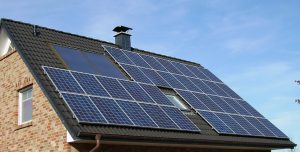Green Building
A green building is a building with a low ecological footprint during its construction and operation, that is, it uses few exhaustible natural resources and it produces low amounts of air, liquid and solid pollutants.
Green building
In order for a building to be categorized as ‘green building’, the following indexes can possibly be used:
- Its greenhouse gas emissions
- The primary energy consumption in it
- Water consumption in it
- The emission of various pollutants by it
Nowadays, as the problems of the exhaustion of natural resources and the pollution of the environment are getting worse and worse, it is of the utmost importance to construct new green buildings, as well as to reconstruct old buildings so as to be transformed into green ones.
The energy consumption in a building is also becoming an essential matter for many reasons, such as the gradual increase in the price of electricity and other fuels. It is known that energy is consumed in a building in order to cover lighting needs, as well as for the operation of electrical appliances, the production of domestic hot water, the heating and cooling of the building. If we take, for instance, a residence of 100 square meters on the island of Crete and calculate its energy and heating oil consumption for a 40-year period, we will discover that the cost of the energy consumed during this period exceeds the two-thirds of its purchase price. If this residence is situated in Northern Greece, where heating needs are considerably more than heating needs on Crete, we can ascertain that the cost of the energy consumed in this residence during this 40-year period exceeds its purchase cost.
Consequently, taking today’s high energy prices into account, as well as their prospective rise in the future at a percentage higher than inflation, the good energy behavior of a building, i.e. the consumption of low amounts of energy for the achievement of a satisfactory result, is rendered essential for its owner or user.
Energy consumption in the buildings of our county and the E.U. corresponds approximately to 40% of the total energy consumption, while the rest is consumed in industry, transportation and agriculture. Nowadays, with the existing technologies it is easier and more economical to save energy in buildings rather than in the other sectors. For this reason, special care is placed on this matter. The construction of
green – environmentally-friendly buildings demands the existence of well-trained scientific and technical staff.
The benefits from the construction of green buildings, whether they are new or reconstructed old ones, are numerous and very important and they concern all the sectors of economy and society.
There are a lot of environmental benefits, as a green building consumes fewer natural resources – water, fuels, electricity – and produces lower amounts of pollutants – air pollutants because of fuel burning, liquid waste and solid litter. The possibility of use of renewable energy sources instead of fossil fuels allows the building to emit a lower amount of greenhouse gases.
The energy benefits are also important. The reduction of energy consumption in buildings, e.g. of natural gas or oil, which are imported fuels, improves the country’s energy balance and enhances our energy security and adequacy. The replacement of fossil fuels with renewable energy sources or the use of solar energy for the production of electricity has the same positive results, too.
The construction of green buildings has numerous benefits for their users, as well as for the local and national economy.
For the user of a green building, the reduced energy consumption results in a reduction of the cost of the power and fuels needed.
The construction of green buildings also entails numerous social benefits related to new working positions which are created in local companies involved in energy conservation systems in buildings, systems for the exploitation of RES (Renewable Energy Sources) for energy production in buildings, production of biomass for use in buildings etc.
The technologies available for the construction of green buildings are nowadays economically efficient and technically reliable. We indicatively mention the various technologies of thermal insulation of a building, the use of solar energy for the production of domestic hot water, the use of solid biomass for heating, the use of geothermal heat pumps for the heating and cooling of a space, the use of photovoltaic installations for the production of electricity, the use of systems of co-production of heating and electricity (for big buildings) etc.
The institutional framework for the construction of green buildings has been formulated after the issuing of European directives and the consequent harmonization of the Greek legislation with them. Initially, the European directive 2002/91 established energy inspection in buildings, while the most recent European directive 2010/31 establishes the concept of buildings with almost zero energy consumption. According to this directive, the buildings that will be constructed after 2021 must consume minimum energy; and whatever energy is consumed must come, to a great degree, from renewable sources.
With the passing of these two European directives, it is clear that in the first 20-year period of the 21st century a new institutional framework is formulated, according to which the new buildings in the European Union will be gradually getting ‘green’, reducing their energy consumption and their ecological footprint due to energy use in them. As a result of this new institutional framework, the European Union – and, of course, Greece as well – will gradually reduce their dependence on imported energy resources, they will increase the use of domestic renewable energy resources, they will reduce greenhouse gas emissions due to energy use and finally they will increase their energy security at a time of intense geopolitical turbulence.
For the construction of green buildings or for the reconstruction of already existing buildings into green ones, there has to be funding of the sustainable energy technologies that will be used. Despite the financial crisis in our country, there are nowadays various funding tools which support the use of such technologies and involve the following:
- Providing grants for the use of sustainable energy technologies in various buildings (eg. hotels) (it concerns subsidization of the initial capital)
- Providing grants for the energy upgrading of a residence (‘Saving’ program)
- Providing grants for the use of photovoltaic installations for the production of electricity in buildings (it concerns the price guarantee of the KWH sold to the network)
- Investment possibilities by companies providing energy services on sustainable energy systems in buildings
Thus it is clear that the construction of green buildings nowadays is indeed a necessity as well as a challenge for our country, with multiple environmental, energy-related, economic and social benefits for their owners/users and for our country, too.

